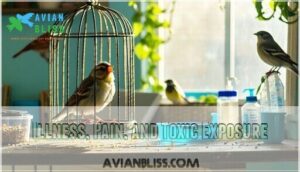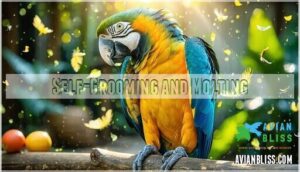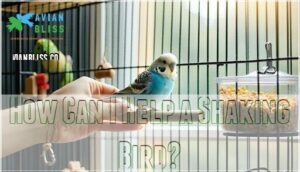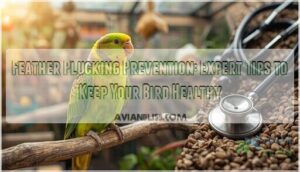This site is supported by our readers. We may earn a commission, at no cost to you, if you purchase through links.
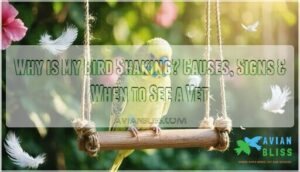
The difference between a contentment quiver and a medical emergency often comes down to subtle details: Is your bird also fluffing its feathers? Has its breathing changed? Learning to read these physical and behavioral cues will help you determine whether you’re witnessing routine bird behavior or a veterinary crisis that can’t wait.
Table Of Contents
- Key Takeaways
- Why is My Bird Shaking?
- What Causes Birds to Shake?
- How Can I Help a Shaking Bird?
- When Should I Call a Veterinarian?
- Frequently Asked Questions (FAQs)
- What does it mean if a bird is shaking?
- What to do if a bird is shivering?
- What does it mean when birds vibrate?
- What causes shivering in birds?
- Can certain foods cause shaking in birds?
- Is shaking a sign of bird aggression?
- How long should normal bird shaking last?
- Can bird shaking spread to other birds?
- Do certain foods reduce or increase shaking?
- How long does normal shaking typically last?
- Conclusion
Key Takeaways
- Bird shaking splits into two categories: normal behaviors like post-bath ruffling and contentment quivers that last seconds, versus warning signs like continuous tremors paired with fluffed feathers, labored breathing, or lethargy that demand immediate veterinary attention.
- Environmental factors—temperature outside the 65-80°F range, sudden loud noises, poor cage placement, or drafts—commonly trigger stress-related shaking that mimics illness but resolves once you adjust the bird’s surroundings.
- Species-specific patterns matter for accurate assessment: parakeets shake from routine changes, cockatiels shiver below 70°F as normal thermoregulation, African greys use head shaking for communication, and canaries tremble from temperature drops or nutritional deficiencies.
- Persistent shaking combined with breathing difficulty, sudden collapse, extreme lethargy, or feather plucking signals urgent illness requiring same-day avian veterinary care, while routine wellness visits every 6-12 months catch subtle problems before they escalate into emergencies.
Why is My Bird Shaking?
When your bird shakes, it’s natural to feel worried—but not all shaking signals trouble. Some movements are perfectly normal, while others warrant immediate attention.
Let’s break down what you’re seeing so you can tell the difference and know when to act.
Normal Shaking Vs. Warning Signs
Not all shaking is cause for alarm—but knowing the difference between a harmless feather ruffle and a genuine red flag could save your bird’s life. Normal shaking patterns include post-bath fluffing for feather care and brief shivers during temperature changes. Warning signs? That’s when shaking persists, intensifies, or pairs with other behavioral cues.
Not all shaking signals danger, but knowing when a harmless ruffle becomes a warning sign could save your bird’s life
- Healthy shake: Your bird vigorously ruffles after bathing, settling each feather into place with rhythmic precision
- Contentment quiver: A brief, full-body shimmy while perched comfortably, often accompanied by soft vocalizations
- Cold response: Occasional shivering in birds when room temperature drops below their comfort zone—should stop once warmed
- Distress tremor: Continuous shaking with fluffed feathers, closed eyes, or labored breathing—signals illness or pain requiring immediate attention
Watch your bird’s body language closely. Stress or fear triggers different avian behavior patterns than physical ailments.
Physical Symptoms to Watch For
Beyond the shaking itself, your bird’s body often tells a more complete story through physical signs that separate routine behavior from genuine medical concern. Look for respiratory issues like labored breathing or tail bobbing, wing tremors that persist beyond normal movement, or shivering paired with fluffed feathers.
Illness or pain may manifest through feather plucking, unusual beak grinding, or erratic head bobbing—all clues your bird’s temperature regulation or avian health is compromised.
Behavioral Indicators of Distress
While physical symptoms offer concrete evidence, your bird’s actions and reactions can reveal stress or fear that’s just as critical. A withdrawn bird who stops singing, suddenly refuses to step up, or sits motionless at the cage bottom may be signaling pain or psychological distress just as loudly as any tremor.
Watch for these anxiety signs:
- Constant feather plucking or self-mutilation
- Excessive beak grinding outside sleep hours
- Aggressive fear responses to familiar people or objects
- Social stress behaviors like cowering or freezing when approached
These patterns in avian behavior and psychology demand your attention just as urgently as shivering in birds does.
Breed-Specific Shaking Behaviors
Different species reveal distinct patterns. Parakeet shaking spikes when environments shift—65% of cases link to sudden noise or routine changes—while cockatiels fluff and shiver below 70°F as part of normal thermoregulation. African grey parrots use head shaking for communication and attention-seeking in 63% of captive individuals, a recognized species trait.
Canary tremors often stem from temperature drops or nutritional gaps, and finch shaking accompanies social interaction and visual attention in 80% of observed events.
Understanding parakeet care tips is essential for identifying the root cause of shaking in birds.
What Causes Birds to Shake?
When your bird shakes, it’s not always a straightforward answer—there’s usually a reason behind it, and pinpointing the cause helps you know whether it’s harmless or something that needs attention.
The triggers range from everyday routines like preening to more serious concerns like illness or environmental stress.
Let’s look at the main factors that cause birds to shake so you can better understand what your feathered friend might be experiencing.
Environmental Factors (Temperature, Noise, Cage Setup)
Your bird’s surroundings can make or break its sense of security—temperature swings, sudden noises, and even the wrong cage placement can trigger shaking episodes that mimic illness. Here’s what you need to monitor:
- Temperature Control and Thermal Regulation – Keep your bird’s environment between 65-80°F to prevent temperature stress and maintain thermal comfort.
- Noise Reduction – Shield your bird cage from sudden sounds like slamming doors or vacuum cleaners that spike anxiety.
- Cage Design and Lighting Effects – Position the cage away from drafts, direct sunlight, and high-traffic areas while maintaining proper humidity levels.
Illness, Pain, and Toxic Exposure
When discomfort strikes, your bird’s body responds with visible tremors that signal something’s gone wrong internally. Illness or infection disrupts normal physiology, causing shaking alongside appetite loss or lethargy—classic toxic symptoms from toxic exposure demand emergency care from an avian veterinarian who specializes in avian toxicology.
Proper illness diagnosis through veterinary care allows effective pain management, protecting bird health when minutes matter most. It’s essential to understand the causes of avian tremors, including avian health issues, to provide the best care for your bird.
Stress, Anxiety, and Fear
Emotional turbulence in your bird’s world—whether from sudden changes, unfamiliar visitors, or overwhelming stimuli—manifests as trembling that looks nearly identical to illness but stems from psychological rather than physical distress. Understanding anxiety triggers helps you identify fear responses through avian psychology:
- Loud noises or sudden movements trigger immediate shaking
- Cage relocation disrupts territorial security and comfort
- New pets or people introduce overwhelming uncertainty
- Routine changes unsettle birds who thrive on predictability
Stress management through calming techniques and emotional support restores equilibrium when anxiety or stress dominates bird behavior and psychology.
Self-Grooming and Molting
Feathers flying loose and your bird vigorously shaking its entire body doesn’t always signal alarm—sometimes it’s just the natural theatrics of preening or the uncomfortable but necessary process of molting.
Preening techniques involve deliberate shaking to redistribute natural oils across plumage, while the molting process triggers discomfort that causes rhythmic trembling.
Feather maintenance through self-grooming and preening and cleaning represents healthy bird behavior essential for plumage care and overall avian care and nutrition.
How Can I Help a Shaking Bird?
If you’ve noticed your bird shaking, there are several steps you can take to help them feel more comfortable and secure. The key is to identify whether the shaking stems from environmental issues, stress, or something more serious that requires veterinary attention.
Let’s look at practical ways you can support your bird’s wellbeing and create a safer, more comfortable space for them.
Monitoring Your Bird’s Behavior
Catching changes in your bird’s daily routine is like reading a medical chart written in feathers and chirps—miss the subtle shifts, and you might overlook early warning signs that could save your companion’s life. Watch for these key indicators of Bird Behavior:
- Changes in vocalizations or social interaction patterns
- Altered eating habits or sudden appetite loss
- Unusual Bird Body Language like prolonged fluffing or withdrawal
- Shifts in feather condition, droppings, or activity levels
Document what you observe—Behavioral Patterns tied to Bird Shaking, Stress and Anxiety in Birds, or Parakeet Shaking often emerge gradually before becoming obvious.
Adjusting The Environment for Comfort
Your bird’s cage isn’t just a container—it’s their entire world, and even small tweaks to temperature, lighting, or placement can mean the difference between comfort and chronic stress.
Aim for thermal comfort between 65–80°F with stable humidity levels around 40–60%. Position the bird cage away from drafts, direct sunlight, and noisy appliances—environmental adjustments like these directly address temperature stress and create the safe haven your companion needs.
Reducing Stress and Providing Enrichment
Once the physical space feels right, mental stimulation becomes just as important—a bored bird is an anxious bird, and enrichment through toys, foraging activities, and social interaction can stop stress-related shaking before it starts. Rotate toys weekly to maintain sensory stimulation, and incorporate calming techniques like gentle music during stressful times.
Your bird behavior analysis should include tracking which environmental factors reduce anxiety—whether it’s puzzle feeders for your parakeet shaking less during foraging or consistent social interaction that soothes avian behavior patterns tied to flock instincts.
Diet and Exercise Recommendations
Proper nutrition and regular physical activity work hand-in-hand with environmental enrichment to keep your bird’s nervous system stable and reduce unexplained shaking. A balanced avian nutrition plan with food variety—pellets, fresh vegetables, and calcium sources—fosters feather care and beak health while preventing deficiencies that manifest as tremors.
Establish a daily exercise routine with supervised out-of-cage time to maintain bird health and wellness, reinforcing nutrient balance and overall pet bird wellness through consistent bird care.
When Should I Call a Veterinarian?
Knowing when your bird needs professional help can be the difference between a quick recovery and a serious health crisis. Some symptoms demand immediate attention, while others warrant a scheduled visit for evaluation.
Let’s walk through the signs that should prompt you to reach out to an avian veterinarian.
Urgent Symptoms Requiring Immediate Care
When should a shaking bird move from "keep an eye on it" to "we need help now"? If your bird shows breathing difficulty, sudden collapse, seizure symptoms, or extreme lethargy signs alongside shaking, don’t wait—these signal serious illness and disease requiring immediate veterinary care.
Feather plucking combined with tremors also warrants an urgent vet visit, as bird health issues can escalate quickly.
Routine Veterinary Check-Ups
Even when your bird seems perfectly healthy, regular wellness visits—ideally every six to twelve months—help catch subtle problems before they snowball into emergencies. Your avian veterinarian can spot weight changes, feather abnormalities, or early disease markers that you might miss at home.
Preventive care through these checkup schedules ensures your bird’s avian wellness stays on track, giving you veterinary guidance specific to your companion’s needs.
Diagnostic Tests and Treatment Options
Several diagnostic approaches help pinpoint why your bird is shaking. Avian blood work screens for infections and organ dysfunction, while fecal analysis detects parasites or bacterial imbalances. Diagnostic imaging—like X-rays—reveals fractures or internal issues. Medication therapy targets infections or pain, and surgical interventions address physical abnormalities. Together, these avian medicine and care tools guide effective veterinary care.
- Fecal smears and cultures expose hidden parasites compromising your bird’s strength
- Blood panels uncover silent organ failure before symptoms worsen
- Radiographs reveal painful fractures your bird can’t communicate
- Targeted antibiotics stop infections stealing your companion’s vitality
- Surgical correction restores function when disease diagnosis demands intervention
Following Veterinary Advice for Recovery
Your bird’s recovery hinges entirely on how faithfully you carry out your veterinarian’s prescribed treatment plan—skipping even one dose of medication or ignoring follow-up appointments can derail weeks of progress. Medication adherence directly impacts bird health, while monitoring progress through home care reveals subtle improvements or setbacks.
| Recovery Element | Your Action | Why It Matters |
|---|---|---|
| Medication adherence | Administer exact doses on schedule | Maintains therapeutic drug levels |
| Follow-up appointments | Return for veterinary care assessments | Adjusts treatment based on response |
| Dietary changes | Implement avian veterinarian recommendations | Aids healing and immune function |
Consistent home care and communication with your veterinary medicine provider guarantee superior avian medicine and care outcomes.
Frequently Asked Questions (FAQs)
What does it mean if a bird is shaking?
If you’ve noticed trembling, there’s a spectrum of interpretations—from contentment after a bath to underlying conditions like illness or hypothermia.
Shaking holds behavioral significance: it might signal stress, excitement, or pain.
Proper severity assessment matters, because shivering in birds can point to causes of bird shaking that need immediate attention.
What to do if a bird is shivering?
If shivering in birds occurs, immediately address thermal regulation by moving your bird to a warmer area and providing gentle heat.
Monitor for hypothermia signs and contact your veterinarian for emergency care—shivering often signals serious bird health concerns requiring professional intervention.
What does it mean when birds vibrate?
Like a hummingbird’s wings creating an invisible blur, rapid feather movement often signals contentment or excitement. Vibration Causes in avian behavior include thermal regulation, feather maintenance, and bird communication.
These shaking patterns reflect normal avian medicine principles—birds vibrate during preening or when anticipating interaction, showing healthy bird behavior rather than distress.
What causes shivering in birds?
When temperatures drop below your bird’s thermal comfort zone, the shivering response kicks in—tiny muscle contractions generate heat to prevent cold stress.
This involuntary mechanism in avian physiology protects essential organs, but persistent shivering signals environmental issues or potential illness requiring attention.
Can certain foods cause shaking in birds?
Yes, certain foods can trigger shaking in birds. Toxic ingredients like avocado, chocolate, or caffeine cause immediate distress, while nutritional deficiencies from poor avian nutrition lead to tremors.
Food allergies and sudden dietary changes also affect bird health. Harrison’s bird foods can help prevent these issues.
Is shaking a sign of bird aggression?
Shaking isn’t usually an aggression sign—it’s more often linked to fear responses or anxiety. Aggressive birds usually display flared feathers, lunging, beak biting, or loud vocalizations.
Understanding bird body language and bird psychology helps you distinguish between fear-driven bird shaking and true aggression signs in your parakeet’s behavior.
How long should normal bird shaking last?
A few seconds is all you’ll usually see—normal bird shaking after bathing or preening lasts just moments as your feathered companion shakes off water or resets feathers.
Shaking patterns that continue beyond brief intervals warrant attention and veterinary care to rule out bird disease diagnosis concerns.
Can bird shaking spread to other birds?
Contagion factors depend on the underlying cause. If your bird’s shaking stems from infectious conditions like psittacosis (caused by Chlamydia psittaci) or other zoonotic diseases, transmission through flock dynamics and bird interactions is possible, affecting avian sociality and requiring immediate veterinary care for birds.
Do certain foods reduce or increase shaking?
Nutrient Balance matters—deficiencies in calcium or vitamin D can worsen tremors, while proper Bird Nutrition and Diet from quality sources like Harrisons bird foods promotes stability.
Food Allergies, poor Digestive Health, or missing Dietary Supplements may trigger shaking, but Calming Treats and expert Parakeet Care guidance from Feathered Friends promote better bird care outcomes.
How long does normal shaking typically last?
Most normal shaking—like after bathing or during preening—lasts just seconds to a few minutes. If your bird’s shaking persists beyond that window or becomes frequent, it’s time to investigate further.
Prolonged episodes often signal environmental stress or underlying health concerns requiring closer monitoring.
Conclusion
Your bird’s trembling might be nothing more than a routine ruffle, or it could be your first glimpse of trouble that needs attention now. Understanding why is my bird shaking enables you to separate benign behaviors from genuine distress.
The difference lies in your willingness to observe closely—watching breathing patterns, energy levels, and whether the shaking passes or persists. Trust your instincts: if something feels off, don’t wait for symptoms to worsen. A quick call to your avian vet can mean the difference between early intervention and irreversible harm.
- https://www.budgiecentral.com/what-temperature-is-too-hot-for-budgies/
- https://vcahospitals.com/know-your-pet/wing-clipping
- https://vetmed.tamu.edu/news/pet-talk/parakeets/
- https://veterinarypartner.vin.com/default.aspx?pid=19239&catId=102911&id=9719484
- https://www.petmd.com/bird/behavior/how-tell-if-your-bird-unhappy-or-stressed-and-what-do


